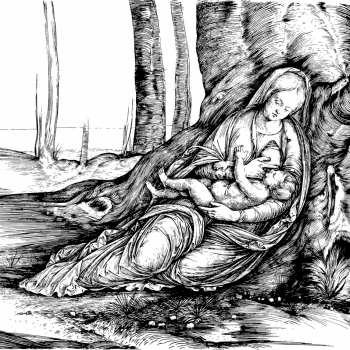
Once again we begin a New Year, full of hope and anticipation; we look forward, resolutely determined to make changes and “do better” this year, in whatever area(s) on which we are focused. At this time of making resolutions and setting intentions, of both worldly and spiritual natures, I wonder if a backward look might also be beneficial. There are years of great forward momentum and years of small, tentative steps, yet we start each year with the same excitement, re-boot our resolutions and tell ourselves that this is THE YEAR, when we’ll “get it right.” Yet, as each year comes to an end, we look back and see a real mix of yes, forward momentum, some sliding backwards, and sometimes, seemingly endless “running in place.” For the truth is, “life” always seems “to call,” interrupting our well-laid plans. The call may come in the form of loss, economic hardship, war, domestic distress, illness, psychological disturbances or spiritual malaise, the possibilities are endless. So, how do I get it “right,” when every new situation seems to pose a different question, when every situation requires a different set of decisions? Is there a common thread? I believe that the answer may be that I need to add to the nature of my resolutions and intentions a healthy dose of humility and surrender – not humility as degrading self-effacement, staring at the ground, denying my gifts and talents, but humility as an unbiased recognition of the truth of any situation and, secondly, surrender, as a willingness to wholeheartedly take on and witness life.
Having been raised Catholic, the idea of spiritual striving to “get it right,” had its birth for me in the beautiful holy cards we regularly exchanged with friends on special occasions – in particular, First Communion and Confirmation. The Saints – holy men and holy women – depicted on the cards had an otherworldly appearance, a paleness as not of real flesh. Even the blood depicted was very clean, not at all messy, as one might expect of a martyr’s death. And then there were the halos, golden, perfect, sometimes so full of goodness that the halos would radiate bits of extra gold into the “real world.” I say this not in any way to diminish the deep piety, love, devotion and spirituality of these most extraordinary people, but only to point out that this depiction made them distinctly unattainable, “other” – you could pray to them, and beseech them to pray for you, but you could never “be” as they were/are.
So, I find that I feel uncomfortable when on occasion, I hear someone call himself or herself an “enlightened” being, or calls me “holy” because of something I’ve said or done. Is it my catholic upbringing? Is it misunderstood humility? Is it a result of the holy cards of my childhood? There is so much backsliding, that honestly, I am much more comfortable, happy even, with the idea of being a “holy human,” than a holy man or holy woman. It seems much more do-able. It doesn’t assume perfection, as soon as, the word “human” enters the conversation. Just the opposite. Words, or rather the stories we surround our words with, are funny, aren’t they?
A “holy human” is fully engaged with the world as it is, acknowledging, surrendering and witnessing, hoping to do just a little better this time. Maybe I will be called upon to be heroic, or maybe I will share a thousand small interactions with my fellow humans this year. Changing the context/expectation of my resolutions is an exercise in humility.
Unlike the crucible of the ascetic lifestyle of John the Baptist and the sadhus of India, the ‘holy human” doesn’t strive for perfection by denying the world, in order to achieve that perfection. Rather, he/she (the holy human) would re-define it. Fr. Seán ÓLaoire would say that perfection is not a “stainless steel sinlessness.” He offers one description of sin as “missing the mark.” We are aware of the target, we aim, but we must practice over and over to eventually strike the center. Life affords us both the opportunity to practice and the feedback we require to succeed.
After each attempt, we repair the arrow, refine our aim/technique, and tighten or loosen the bow. How do we think creatively about how to do that? The great saints and sages refine their technique by choosing a path that allows them to go to the mountain top, to experience transcendence and to take that experience with them back down to earth, to inform their words and actions. Indeed the mountain top can be very attractive, but unlike saints and sages, I find that my life is such, that I spend much more time at the base of the mountain than I do on the mountain top. My perennial hope is to pack up and move my base camp a little higher with each new experience.
My first major opportunity to move my base camp upward came for me at an early age. The experience created an alteration, an evolution in my thinking, or maybe an acknowledgement of the truth that my inner soul Self always knew was there. The groundwork had been laid for years previous. Growing up in the Deep South in the 1960s, life’s call came loudly in the form of desegregation, voting rights, and underserved black children. By then I had borne innocent witness, as only a child can, to the inequality surrounding me and smothering Southern society.
So, what do each of us have in our spiritual “backpacks” for the ascent and descent of the mountain?
- We each have our own set of unique gifts and talents, given to us to use as our way of contributing to the spiritual evolution of the planet.
- We each have a conscience – an inner knowing – a voice that speaks truth to us, when we are quiet enough to listen.
- We each have a desire to connect, love and be loved. Coupled with inner knowing, it manifests as kindness and compassion for all sentient beings.
- We each have a desire to do the right thing. We are, in fact, drawn along the path to the good, and bit by bit, we align ourselves with it.
Conclusion
Life calls to each of us in different ways. We each carry a candle, our own small light through life. Each journey up the mountain changes the quality of our response to life’s call at the mountain’s base. Our journey could be through prayer, meditation, music, art, Nature – any means through which we transcend time and space – where we find truth, beauty, and God (Source) waiting.
The essence of a “good” year or a “bad” year has to do in great part with the quality of our interactions with others, in whatever circumstances, even difficult ones, in which we may find ourselves. Perhaps we commit to learning patience, to cultivating equanimity, to increasing our ability to stay present, to becoming better listeners, to not making assumptions, to allowing others to grow and change as they follow their path, to loosening the chains of unforgiveness that bind us to separation and grief.
How can I raise my base camp a little higher? By meeting each new experience with these virtues from the prophet Micah: to do justice, to love kindness and to walk humbly with your God (Micah 6:8) By birthing better and better versions of ourselves, we walk with God. God is always walking with us, how do we walk with Her?
Maybe St. Theresa of Avila has the answer we are looking for. As the story goes,
One day at dinner she was heartily enjoying the roast partridge. Another nun, a little shocked, asked her if it wouldn’t be better to be praying than to be enjoying dinner. Teresa answered, “When I pray, I pray; when I partridge, I partridge!”
Beloved St. Theresa – saint, holy woman, holy human!












